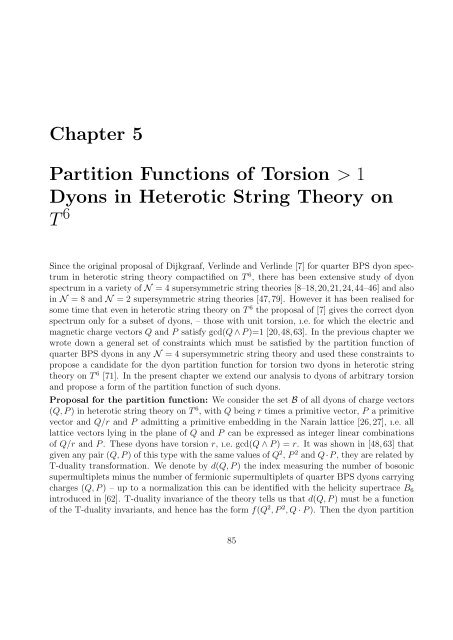PHYS08200604018 Shamik Banerjee - Homi Bhabha National ...
PHYS08200604018 Shamik Banerjee - Homi Bhabha National ...
PHYS08200604018 Shamik Banerjee - Homi Bhabha National ...
You also want an ePaper? Increase the reach of your titles
YUMPU automatically turns print PDFs into web optimized ePapers that Google loves.
Chapter 5<br />
Partition Functions of Torsion > 1<br />
Dyons in Heterotic String Theory on<br />
T 6<br />
Since the original proposal of Dijkgraaf, Verlinde and Verlinde [7] for quarter BPS dyon spectrum<br />
in heterotic string theory compactified on T 6 , there has been extensive study of dyon<br />
spectrum in a variety of N = 4 supersymmetric string theories [8–18,20,21,24,44–46] and also<br />
in N = 8 and N = 2 supersymmetric string theories [47, 79]. However it has been realised for<br />
some time that even in heterotic string theory on T 6 the proposal of [7] gives the correct dyon<br />
spectrum only for a subset of dyons, – those with unit torsion, ı.e. for which the electric and<br />
magnetic charge vectors Q and P satisfy gcd(Q ∧ P )=1 [20,48,63]. In the previous chapter we<br />
wrote down a general set of constraints which must be satisfied by the partition function of<br />
quarter BPS dyons in any N = 4 supersymmetric string theory and used these constraints to<br />
propose a candidate for the dyon partition function for torsion two dyons in heterotic string<br />
theory on T 6 [71]. In the present chapter we extend our analysis to dyons of arbitrary torsion<br />
and propose a form of the partition function of such dyons.<br />
Proposal for the partition function: We consider the set B of all dyons of charge vectors<br />
(Q, P ) in heterotic string theory on T 6 , with Q being r times a primitive vector, P a primitive<br />
vector and Q/r and P admitting a primitive embedding in the Narain lattice [26, 27], ı.e. all<br />
lattice vectors lying in the plane of Q and P can be expressed as integer linear combinations<br />
of Q/r and P . These dyons have torsion r, ı.e. gcd(Q ∧ P ) = r. It was shown in [48, 63] that<br />
given any pair (Q, P ) of this type with the same values of Q 2 , P 2 and Q·P , they are related by<br />
T-duality transformation. We denote by d(Q, P ) the index measuring the number of bosonic<br />
supermultiplets minus the number of fermionic supermultiplets of quarter BPS dyons carrying<br />
charges (Q, P ) – up to a normalization this can be identified with the helicity supertrace B 6<br />
introduced in [62]. T-duality invariance of the theory tells us that d(Q, P ) must be a function<br />
of the T-duality invariants, and hence has the form f(Q 2 , P 2 , Q · P ). Then the dyon partition<br />
85

















